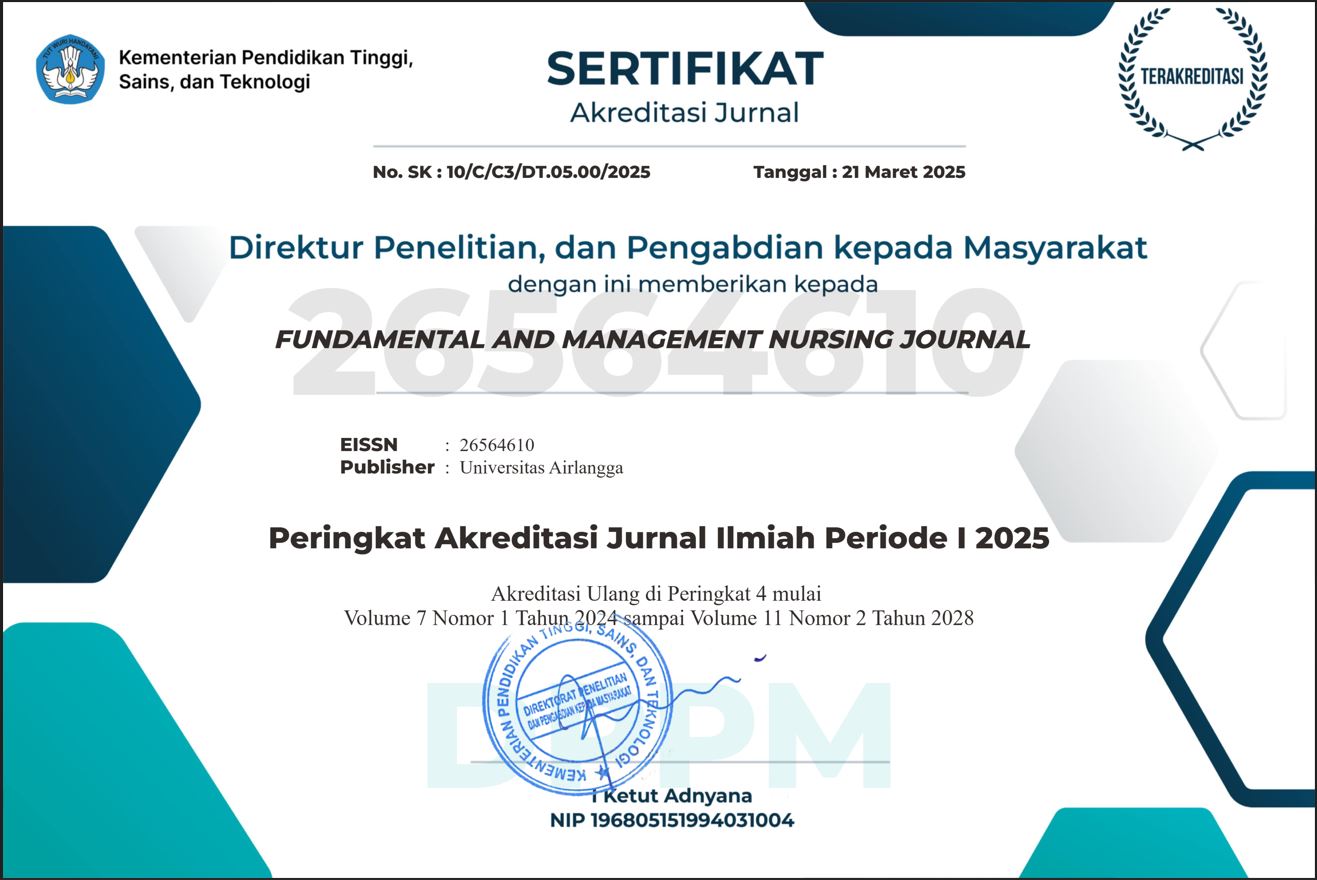Compliance of the Nurse for Fall Risk Re-Assessment Base on Theory of Planned Behaviour
Downloads
Introduction: Increasing the workload of nurses caused the re-assessment of patients fall risk to be rare and can affect the value and quality of the Hospital. This study aims to determine the factors associated with patient compliance with re-assessment of the risk of falls in IRNA Bedah RSUD Dr. Soetomo Surabaya.
Method: This study uses a descriptive correlation design with a cross-sectional approach. Samples in this research was nurses obtained with simple random sampling. Independent variables were attitudes, subjective norms, perceived behavior control, and intention. The dependent variable was compliance with re-assessment of the patient's fall risk. Data were obtained by attitude, subjective norms, perceived behavior control, intention, and compliance with re-assessment questionnaires and analyzed with Spearman's Rho with α = 0,05%.
Result: Statistical test results showed that there was a significant relationship (p = 0.010) between attitudes and nurses' intentions in re-assessment of risky patients with weak correlation levels (r = -0.292), there was a significant relationship (p = 0.001) between Subjective norms with nurse intentions on re-assessment of falling risk patients with weak correlation levels (r = 0.281), there is a significant relationship (p = 0.007) between perceived behavioral control and nurses' intentions on re-assessment of falling risk patients with weak correlation levels ( r = 0.237), there is a significant relationship (p = 0,000) between intention and nurse adherence in re-assessment of patients' risk of falling with a fairly strong correlation level (r = 0.541).
Conclussion: Intention has the strongest relationship in reassessing falling risk patients. Attitudes, subjective norms, and perceived behavioral control also be a factor in increasing nurse participation in reassessing a patient's risk of falling. Supervision and control of nurses' approval is needed in reassessing patients at risk of falling.
Ajzen, I. (2005). Attitudes, Personality and Behavior (2nd ed.). New York: Open University Press.
Callis, N. (2016). Falls prevention: Identification of predictive fall risk factors. Applied Nursing Research, 29, 53–58. https://doi.org/10.1016/j.apnr.2015.05.007
Cruz, S., Carvalho, L., & Lopes, E. (2016). Improving the Evaluation of Risk of Fall through Clinical Supervision: An Evidence. Procedia - Social and Behavioral Sciences, 217, 382–388. https://doi.org/10.1016/j.sbspro.2016.02.108
Grubaugh, M. L., & Flynn, L. (2018). Relationships among Nurse Manager Leadership Skills, Conflict Management, and Unit Teamwork. Journal of Nursing Administration, 48(7–8), 383–388. https://doi.org/10.1097/NNA.0000000000000633
Haigh, R., Borthwick, D., Kalorkoti, J., McMillan, M., & Knowles, G. (2016). Development and implementation of nursing grand rounds in a cancer centre. Cancer Nursing Practice (2014+), 15(5), 24. https://doi.org/http://dx.doi.org/10.7748/cnp.15.5.24.s22
JCI. (2015). Accreditation Participation Requirements, (January).
Liu, H., & Zhang, C. (2010). Research on information engineering surveillance risk evaluation based on fault tree analysis. Proceedings - 2010 3rd IEEE International Conference on Computer Science and Information Technology, ICCSIT 2010, 4, 601–605. https://doi.org/10.1016/j.pedn.2018.04.003
Lunsford, B. (2015). Assessing your patients' risk for falling. American Nurse Today, 10(7), 29–31.
Luthfiyah, A. N. (2016). Factor of Hand Hygiene Nurse and Midwife Based Complience and Adherence Theory. Repository Unair, 2016.
Mata, L. R. F. da, Azevedo, C., Policarpo, A. G., & Moraes, J. T. (2017). Factors associated with the risk of fall in adults in the postoperative period: a cross-sectional study. Revista Latino-Americana de Enfermagem, 25(0). https://doi.org/10.1590/1518-8345.1775.2904
McKinn, S., Bonner, C., Jansen, J., Teixeira-Pinto, A., So, M., Irwig, L., ... McCaffery, K. (2016). Factors influencing general practitioners' decisions about cardiovascular disease risk reassessment: Findings from experimental and interview studies. BMC Family Practice, 17(1), 1–10. https://doi.org/10.1186/s12875-016-0499-7
Nur, H. A., Dharmana, E., & Santoso, A. (2016). Pelaksanaan asesmen risiko jatuh di Rumah Sakit. Indonesian Journal of Nursing and Midwifery, 7642(2), 123–133.
Nurishan, R., & Sari, N. K. (2018). Nurse Adherence in Implementing Interventions Procedures for High Risk Patients Fall in General Hospital Wates Kulon Progo. Respository UMY, 3–16.
Nursalam. (2013). Metodologi Penelitian Ilmu Keperawatan: Pendekatan Praktis edisi (3rd ed.). Jakarta: Salemba Medika.
Nursalam. (2015). Metodologi Penelitian Ilmu Keperawatan: Pendekatan Prakti. Jakarta: Salemba Medika.
Palumbo, P., Klenk, J., Cattelani, L., Bandinelli, S., Ferrucci, L., Rapp, K., ... Rothenbacher, D. (2016). Predictive Performance of a Fall Risk Assessment Tool for Community-Dwelling Older People (FRAT-up) in 4 European Cohorts. Journal of the American Medical Directors Association, 17(12), 1106–1113. https://doi.org/10.1016/j.jamda.2016.07.015
Pham, J. C., Hoffman, C., Popescu, I., Ijagbemi, O. M., & Carson, K. A. (2016). A tool for the concise analysis of patient safety incidents. Joint Commission Journal on Quality and Patient Safety, 42(1), 26–33. https://doi.org/10.1016/S1553-7250(16)42003-9
Putri, D. P., Publikasi, N., Studi, P., Keperawatan, I., Kedokteran, F., & Tanjungpura, U. (2017). Analisa pelaksanaan asesmen pencegahan risiko jatuh pasien oleh perawat di rumah sakit universitas tanjungpura pontianak.
ravika ramlis. (2017). FAKTOR-FAKTOR YANG BERHUBUNGAN DENGAN RESIKO JATUH PADA LANSIA DI BPPLU KOTA BENGKULU TAHUN 2017.
Smith, D. A. (2018). Documented, Systematic and Individualized Communication With the Attending Physician for Fall Risk Reduction/Injury Mitigation Care Planning. Journal of the American Medical Directors Association, 19(8), 714–716. https://doi.org/10.1016/j.jamda.2018.05.032
Sutoto, Atmodjo, D., Luwiharsih, Lumenta, N. A., Reksoprodjo, M., Martoatmodjo, K., ... Saleh, J. T. (2012). Instrumen Akreditasi Rumah Sakit Standar Akreditasi Versi 2012, 1, 1–350. https://doi.org/10.1017/S1366728917000682
Uddin, J., Chandra, N., Islam, Z., Ansary, I., Quaiyum, M. A., & Perez, T. (2012). Improving low coverage of child immunization in rural hard-to-reach areas of Bangladesh : Findings from a project using multiple interventions. Vaccine, 30(2), 168–179. https://doi.org/10.1016/j.vaccine.2011.11.030
Xue, Y., Aiken, L. H., Freund, D. A., & Noyes, K. (2012). Quality outcomes of hospital supplemental nurse staffing. Journal of Nursing Administration, 42(12), 580–585. https://doi.org/10.1097/NNA.0b013e318274b5bc
1. The journal allows the author to hold the copyright of the article without restrictions.
2. The journal allows the author(s) to retain publishing rights without restrictions.
3. The legal formal aspect of journal publication accessibility refers to Creative Commons Attribution (CC BY).
















